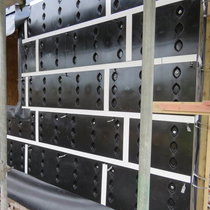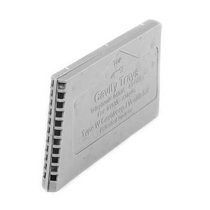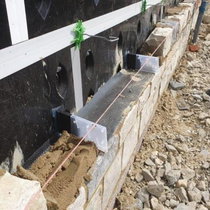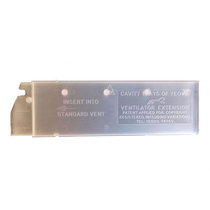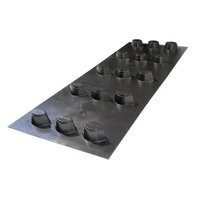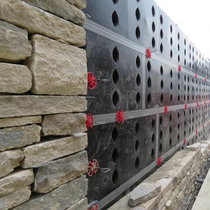Brand: Surecav
Material Composition and Construction Benefits
SureCav panels are made entirely from recycled polypropylene, which offers several benefits for construction in the UK.
This material is injected into moulds to create sturdy, uniform panels that guarantee consistent strength across projects. The lightweight nature of polypropylene means panels are 100 times lighter than traditional concrete blocks, making handling and installation easier, quicker, and less labour-intensive.
Durable and resistant to corrosion, polypropylene maintains its integrity over the building’s lifespan, unlike metal or concrete that may degrade over time.
Because it's non-conductive, SureCav panels also help eliminate thermal bridging.
Using recycled material not only supports sustainability but also reduces waste, making these panels an innovative, environmentally friendly choice for building professionals seeking a sense of community through responsible construction practices.
Environmental Advantages of SureCav Systems
Using recycled polypropylene instead of traditional concrete backing blocks significantly reduces the environmental impact of cavity wall construction.
SureCav helps to cut down carbon emissions by replacing concrete, saving approximately 3,900 lorry loads of concrete over ten years. This switch nearly halves the embodied CO₂ compared to concrete blocks and requires less energy during manufacturing.
Recycled plastic also diverts waste from landfill and incineration, giving plastics a second life. Its lightweight design reduces transportation emissions and minimises environmental disturbance, while the system's durability reduces waste from repairs or replacements.
Additionally, SureCav eliminates the need for quarrying and processing natural aggregates, thereby preserving resources.
Recycling plastic waste further decreases the environmental footprint of construction projects, making SureCav a sustainable and eco-friendly choice, supporting builders who wish to reduce their environmental footprint.
Construction Efficiency and Cost Savings
SureCav systems assist in accelerating construction by enabling quicker installation compared to traditional methods. They also reduce labour costs, as fewer skilled workers are required and the handling of lightweight panels is more manageable. Furthermore, utilising these materials diminishes overall expenses by lowering material costs and streamlining supply chains. The high availability of SureCav products ensures timely project completion and reduces delays related to material shortages availability.
Faster Installation Processes
Faster installation processes significantly enhance construction efficiency and reduce costs by streamlining on-site procedures and minimising delays.
Surecav’s lightweight, recycled plastic components are easier to handle and transport, eliminating the need for heavy machinery typically required with concrete blocks. This results in fewer delivery trips—77 lorry loads instead of 2,500—saving time and reducing congestion.
Its modular design allows for quick assembly without the need to wait for curing, thereby expediting the building process. Compatibility with timber frames and screw attachments further accelerates installation.
Additionally, its weather-resistant parts mitigate delays caused by rain. Made from 100% recycled polypropylene, its durability ensures long-term performance, further reducing maintenance costs over the building’s lifespan. Overall, these innovations enable projects to progress more swiftly, shorten timelines, and reduce expenses, making construction more streamlined and efficient for all parties involved.
Reduced Labour Expenses
The construction industry in the UK can benefit significantly from reduced labour expenses, especially when innovative systems streamline building processes.
SureCav simplifies construction by eliminating the need for additional backing walls, thereby reducing the required manpower. Its lightweight design necessitates less physical effort, which:
- speeds up handling and installation,
- minimises workplace fatigue and accidents,
- allows for quicker site setup, leading to faster project completion.
These features enable contractors to save money on labour costs and enhance overall efficiency. Moreover, the reduced need for heavy machinery and fewer skilled workers further contributes to lowering project expenses by decreasing the reliance on specialized equipment.
Fewer workers are needed for handling, installation, and site activities, which reduces project expenses. Additionally, the ability to reallocate resources more easily and complete projects more swiftly benefits all parties involved.
Material Cost Efficiency
Effective material management is crucial for controlling construction costs and enhancing overall efficiency.
Strategic sourcing plays a key role, with direct negotiations helping to secure better prices and long-term contracts protecting against price increases. Proactive purchasing, which involves acquiring materials early, also ensures favourable rates.
Accurate estimation reduces waste and unnecessary purchases, while exploring alternative materials can lower costs without compromising quality. Reducing waste through recycling and reclaiming further cuts expenses and promotes sustainability.
Advanced methods such as modular and prefabricated construction minimise on-site waste and labour, combining efficiency with quality.
Optimising logistics by working closely with transportation hubs and planning deliveries ensures that materials arrive when needed, preventing delays and additional costs.
Additionally, implementing cost-effective materials like LVL and AAC can significantly reduce material expenses while maintaining structural integrity and safety standards.
Collectively, these approaches make construction more cost-efficient and environmentally responsible, benefiting all parties involved.
Technical Features and Specifications
Surecav offers cavity size options of 25mm and 50mm to accommodate various building requirements, ensuring the perfect fit for each project.
Its moisture control features include a moisture-free cavity, water resistance, and ventilation pathways that prevent condensation and dampness. Certified by industry standards, the system ensures reliable performance over time. This combination of technical specifications enhances wall performance, making Surecav a dependable choice for contemporary construction in the UK.
Cavity Size Options
Cavity size options for SureCav panels include 25mm and 50mm thicknesses, designed to suit various wall types and comply with modern energy standards. These options enable builders to customise wall designs for diverse applications. Consider the following images:
-
A 25mm cavity creates a residual gap in stone or brick walls, providing sufficient space for insulation without adding bulk.
-
The 50mm variant replaces traditional blockwork on slate or brick exteriors, offering a weather-resistant layer for enhanced durability.
-
Both sizes adapt to any UK climate, with flexible exposure zones, and can be utilised in masonry, timber-frame, or steel internal leaves.
These cavity options render SureCav highly versatile, ensuring efficient thermal performance without compromising structural integrity or design flexibility. This flexibility allows for seamless integration into various construction methods, further enhancing the system's suitability across projects.
Moisture Control Features
Moisture control is a vital aspect of building wall systems, and SureCav addresses this need with advanced technical features. The system creates a permanent barrier that stops water from penetrating porous masonry, keeping the cavity dry and well-ventilated. The system's innovative design includes built-in drainage channels that direct any moisture away from the wall structure. It maintains consistent 25mm or 50mm clear cavities essential for airflow and moisture removal. The moisture-beating panels securely hold insulation, reducing heat loss and the risk of dampness. The cavity backing prevents mortar contamination, which could lead to moisture bridging and compromise wall ties. The panels have a special groove that channels any infiltrating moisture back to the outer leaf for drainage via weep vents. Certified to resist wind-driven rain, SureCav keeps the inner cavity dry even in harsh weather, ensuring long-term durability and effective moisture management.
Compatibility With Different Building Materials
Compatibility with different building materials is a key feature that makes SureCav a versatile choice for construction projects. It works well with conventional masonry inner leaves such as clay, calcium silicate, concrete, and stone units. Made from 100% recycled polypropylene, SureCav panels can adapt to various environmental and sustainability standards, enhancing its suitability across different building types. Imagine building a wall where:
- Natural or reconstituted stone outer leaves sit directly against the SureCav panels, creating a seamless fit.
- The system supporting brick or concrete block outer leaves allows for strong, durable walls.
- The panels provide a stable backing for fixing stone, brick, or slate finishes, ensuring proper alignment.
This flexibility helps builders create various wall systems without sacrificing structural integrity. It enables quicker construction while maintaining quality.
Furthermore, it prevents mortar droppings and moisture intrusion, ensuring that the entire wall remains durable and weather-resistant.
Certification and Regulatory Compliance
Building regulations play an essential role in ensuring that construction products meet safety and quality standards, and SureCav systems are designed to comply with these requirements.
They conform to the Building Regulations 2010 in England and Wales, which include specific provisions to prevent the spread of fire and control moisture.
SureCav holds a BBA Agrément Certificate (04/4154), confirming that it meets UK standards for durability and fire resistance.
The system also complies with moisture resistance requirements by preventing water penetration and issues related to condensation.
The quality of materials, such as the use of recycled HDPE and corrosion-resistant fixings, adheres to strict safety and environmental guidelines.
Furthermore, installation must follow the manufacturer's instructions and be inspected by third parties to guarantee ongoing compliance.
Installation Methods and Best Practices
Proper installation of SureCav panels is essential to guarantee their performance and durability. The key steps involve fixing panels securely, aligning them correctly, and verifying airtight seals.
To install effectively:
- Secure each panel with five stainless steel screws and seal washers, creating a firm connection.
- Use horizontal joining strips to connect rows, providing a smooth, continuous appearance.
- Trim panels precisely around doors, windows, and other obstructions to ensure a neat fit.
Insulation sheets are placed behind the panels to enhance thermal efficiency, while sealant around frames prevents leaks.
Additional wall ties help hold panels in place without the need for cutting. Following these best practices results in a robust, weatherproof, and energy-efficient building that's part of a community committed to quality and sustainability.
Applications in Modern Building Projects
Modern building projects in the UK often incorporate SureCav panels to enhance both aesthetics and performance. These panels complement various masonry finishes such as brick, stone, flint, and slate, providing a clean surface that elevates the building’s appearance.
They're also utilised in retrofitting existing structures, boosting durability and efficiency. Made from recycled polypropylene, SureCav reduces carbon emissions and minimises material waste, supporting green building practices.
In timber-frame and SIPS construction, the panels are lightweight, saving space, and increasing internal floor area by up to 6%. They require narrower footings, which reduces excavation efforts.
Conclusion
SureCav systems offer a durable, efficient, and environmentally friendly solution for modern construction in the UK. Their compatibility with various materials, ease of installation, and compliance with regulations make them a popular choice within the industry. By improving construction efficiency and reducing costs, SureCav provides a reliable option for building projects of all sizes. Overall, these systems combine technical innovation with practical benefits, making them a valuable addition to contemporary building practices across the nation.

